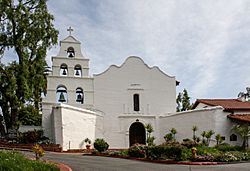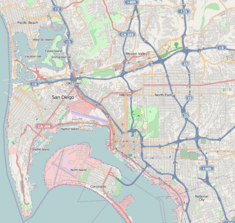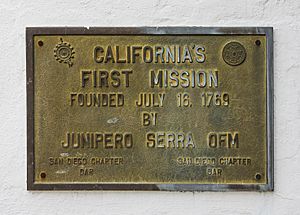Mission San Diego de Alcalá facts for kids

The church façade of Mission San Diego de Alcalá
|
|
| Location | 10818 San Diego Mission Rd. San Diego, California 92108-2429 |
|---|---|
| Coordinates | 32°47′4″N 117°6′23″W / 32.78444°N 117.10639°W |
| Name as founded | La Misión San Diego de Alcalá |
| English translation | The Mission of Saint Didacus of Acalá |
| Patron | Saint Didacus of Alcalá |
| Nickname(s) | "Mother of the Alta California Missions" |
| Founding date | July 16, 1769 |
| Founding priest(s) | Father Presidente Junípero Serra |
| Built | 1769 |
| Architect | Fr. Jose Bernardo Sanchez |
| Founding Order | First |
| Headquarters of the Alta California Mission System | 1769–1771 |
| Military district | First |
| Native tribe(s) Spanish name(s) |
Kumeyaay (Ipai / Tipai) Diegueño |
| Native place name(s) | Kosoi, Nipawai |
| Baptisms | 6,522 |
| Confirmations | 1,379 |
| Marriages | 1,794 |
| Burials | 4,322 |
| Neophyte population | 1,455 |
| Secularized | 1834 |
| Returned to the Church | 1862 |
| Governing body | Roman Catholic Diocese of San Diego |
| Current use | Parish Church |
| Official name: San Diego Mission Church | |
| Designated | April 15, 1970 |
| Reference no. | 70000144 |
| Designated | April 15, 1970 |
| Reference no. | #242 |
| Designated | October 6, 1976 |
| Reference no. | 113 |
Mission Basilica San Diego de Alcalá was the second mission built by Spanish Franciscans in California. It was part of New Spain, a large area controlled by Spain. The mission is located in what is now San Diego, California. It was founded on July 16, 1769, by a Spanish friar named Junípero Serra. This area had been home to the Kumeyaay people for a long time.
The church building you see today was built in the early 1800s. It is actually the fifth church to stand on this spot. The mission site is a very important historical place, known as a National Historic Landmark. The mission and the area around it were named after a Catholic saint from Spain, Didacus of Alcalá, also known as San Diego. This mission was also the site of the first Christian burial in Alta California (Upper California).
Contents
The Mission's Early Days
The area where Mission San Diego was built was originally called Nipawai by the Kumeyaay people. These native people are also known as the Diegueño. We know a lot about them thanks to explorers like Juan Rodríguez Cabrillo. He explored the coast for Spain in 1542. Cabrillo was the first European to visit what is now California. He also discovered San Diego Bay, naming it "San Miguel".
About 60 years later, another Spanish explorer, Sebastián Vizcaíno, arrived. He landed near the future mission site in 1602. Vizcaíno renamed the port "San Diego de Alcalá". It would be another 167 years before the Spanish returned to San Diego.
Why Missions Were Built
Since the time of Christopher Columbus, Spain wanted to build missions. These missions aimed to teach Roman Catholicism to native people. They also helped Spain claim and settle new lands. In 1769, an important Spanish leader, José de Gálvez, sent an expedition. This group, led by Junípero Serra and Gaspar de Portolà, was to build missions and forts (called presidios). Their goal was to secure Spain's control over the Pacific coast harbors.
Challenges and Rebuilding
The first mission church was destroyed by fire in 1775. This happened during an uprising by local native people. About 800 "American Indians" attacked the mission, burning it down. Sadly, Father Luis Jayme was killed during this attack. He is known as California's first Catholic martyr. Father Jayme is buried near the altar in the current church.
Father Serra returned in 1776 to help rebuild the mission. However, it was hard to find enough water and prepare the land for farming. This made rebuilding a long and difficult process. For many years, the mission focused on raising horses and mules. They provided about 16 animals each year to other missions. After it was rebuilt, the mission saw many baptisms, with 567 new members joining.
Changes Over Time
Rancho Period (1834–1849)
In 1834, the Mexican government decided to close the missions. This was called the "Decree of Confiscation". Mission lands were broken up into large farms called ranchos. These were given to former military officers. In 1846, Mission San Diego de Alcalá was given to Santiago Argüello. After the Mexican–American War, the United States military used the mission from 1846 to 1862.
Returning to the Church (1850–1900)
On May 23, 1862, Abraham Lincoln, who was President at the time, signed a paper. This paper gave ownership of the mission back to the Roman Catholic Church. When the mission was returned, it was in ruins. In the 1880s, Father Anthony Ubach started to restore the old mission buildings.
Modern Era (1901 – Present)
Father Ubach passed away in 1907, and restoration work stopped for a while. It started again in 1931. In 1941, the mission became a parish church once more. It is still an active church today, serving the Roman Catholic Diocese of San Diego. In 1976, Pope Paul VI gave the mission church a special title: a minor basilica.
Today, Mission San Diego de Alcalá is located within San Diego city limits. It is near the intersection of Interstate 8 and Interstate 15.
Mission Life and Industries
The main goal of the missions was to become self-sufficient. This meant they needed to grow their own food and make their own goods. Farming was the most important activity at any mission. Before the missions, native people were skilled at using natural materials like bone, shells, stone, and wood. They used these for building, making tools, and weapons.
The missionaries taught the native people new skills. These included farming, mechanical arts, and caring for livestock. Everything the people at the mission used was produced there. This meant the native people not only supported themselves but also helped support the government of California after 1811.
Major crops at San Diego included wheat, corn, wine grapes, barley, and beans. They also raised cattle, horses, and sheep. In 1795, work began on a system of aqueducts to bring water to the fields and the mission. This was the first irrigation project in Upper California.
California's First Vineyards
The very first vineyards in California were planted at Mission San Diego in 1769. Father Junípero Serra planted these first grapevines. The grapes were a type called "Mission" grapes, which had been brought to Mexico in the 1500s. While these first plantings didn't survive, Mission San Juan Capistrano later had the first successful vineyards. By 1781, Mission San Diego was producing wine. Some sources say the mission's vineyards grew to be very large, covering many acres.
Images for kids
-
Natives using a simple plow to prepare a field near Mission San Diego de Alcalá.
See also
 In Spanish: Misión San Diego de Alcalá para niños
In Spanish: Misión San Diego de Alcalá para niños
- Spanish missions in California
- List of Spanish missions in California
- Presidio of San Diego
- USNS Mission San Diego (AO-121) – a ship named after the mission.









